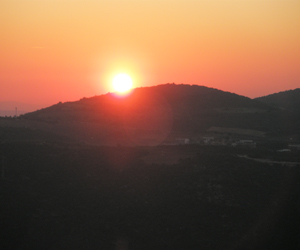Tel Hai
Settlement in the North
To understand the history, politics and ideology of modern Jewish settlement in Israel, one must understand the history of Tel Hai.
Tel Hai, the "Hill of Life" is, today, a small community college located on the northern edge of Kiryat Shmoneh. It is pastoral and scenic, and lies just a few kilometers south of the Lebanese border.
The history of Tel Hai is firmly entrenched in the story of Zionist settlement of Israel. Tel Hai was one of the first four Jewish settlements of the far north in the early years of the 20th century, along with Metulla, Hamra and Kfar Giladi. The farmers of these settlements battled the elements, lack of agricultural experience and local Bedouin raiders in order to establish their settlements.
The settlers of Tel Hai were unique in that they followed the Jewish Revisionist Movement's outlook on a political future for the upcoming Jewish State. While the Labor Zionists, led by David Ben Gurion, advocated settlement as a first priority, and believed that the goal of establishing a Jewish Nation should not be publicized so as not to antagonize the ruling powers, the Revisionists, under the leadership of Zev Jabotinsky, argued that Jews should make no secret of their intention to arm themselves and ready themselves for an armed conflict. Today's Likud political party, one of Israel's two largest, is the political offspring of the Revisionist Movement.
The Tel Hai settlers, members of the "Galilee Farmer's Union" built a fortress at Tel Hai and began to cultivate the land. The fortress was a communal living area which was designed to enable the members of the community to protect each other and ward off Bedouin attacks which were common in the area at that time. They could not, however, ward off a massive attack in 1920, and eight members of the settlement were killed, including their leader, the one-armed Joseph Trumpledor.
Last Words
Trumpledor's last words are famous in Israel until today, for they embody the belief of the Jews of Israel as they defend their country. "It is good to die for one's country" he said, and some believe that he added "And it is good to have a country to die for".
Today, the Tel Hai museum is open daily. Visitors come to view the exhibit which explains the history of the settlement and the ideology which brought further groups of settlers to the area after the original settlers of Tel Hai were forced to leave. The nearby town of Kiryat Shmoneh, meaning "Town of Eight" is named after the settlers who died in 1920, and visitors are left with the understanding that Israel's existence today is due to them, and people like them, who put their own personal lives at risk for the ideal of a Jewish State.

